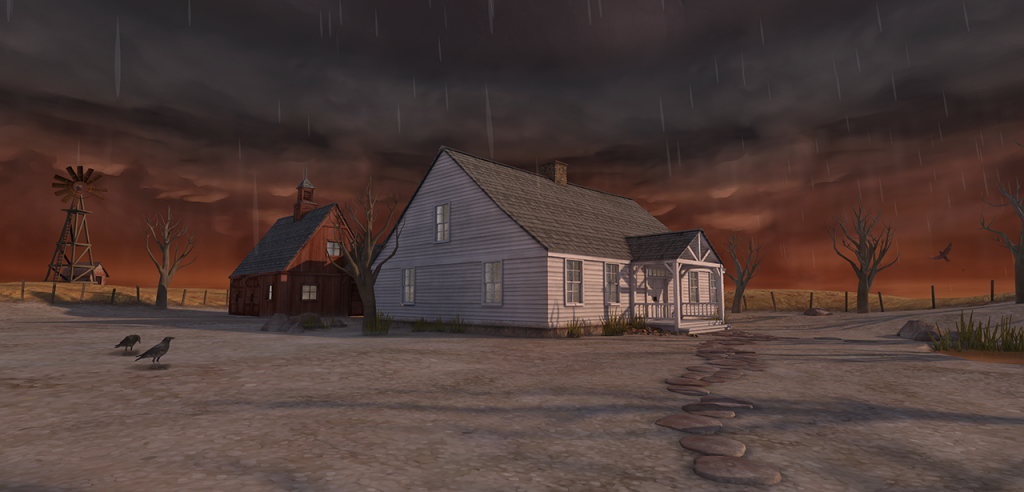
I gave a talk at GDC 2015 about designing our new title, Dead Secret, for mobile VR platforms like the Gear VR. That seemed to go over well, so I thought I’d write a little bit about the design of the game itself.
Dead Secret is a murder mystery that takes place entirely within the home of the victim. Your goal is to search the house for clues, piece together the events leading up to the death, and finally name the killer. In designing this game one of the main challenges has been to define how the physical space, puzzles, and pacing interact. This can be thought of as the problem of density: what is the effect of packing lots of information into a small space compared to spreading it out over a larger space?
To some extent, this question is answered for us by other design decisions we’ve made. The house in Dead Secret is based on real architectural plans for a home of the proper era and location. It’s not a mansion, it’s a two story home with one bathroom, two bedrooms and, ahem, a basement. We’ve made some modifications here and there, and some of the game takes place outside the home itself. But the space is relatively small.
More importantly, individual rooms are sized the way they should be, which means that once we fill them with bookshelves, tables, cupboards, and esoteric 19th-century mechanical instruments, there’s not a whole lot of space to get into a firefight, parkour up a wall, or even sneak through some air ducts. This house is old enough that it doesn’t even have air ducts.
By electing a dense, cramped environment, we implicitly closed the door on things like shooting and platforming. It’s a good thing, too, because those sorts of interactions typically rely on locomotion systems that probably make people sick in VR. Instead, Dead Secret is about exploration, about finding clues, and about solving puzzles. For this, the tight, contained space of the house works really well. We can pack a ton of detail into each room and simplify our locomotion system to encourage methodical investigation. One of the most surprising aspects of VR for us is the sense of spaciousness of virtual spaces. When the scale is right, an environment that appears noisy and cluttered on a screen feels open and airy in VR.
The tight coupling of rooms also lets us engage in a level design pattern that I call recursive unlocking. Recursive unlocking describes a map design with tightly packed rooms connected by doors that are initially locked. The space available to the player starts out small, but as they unlock one room after another it begins to unwind like a shell. Rooms interconnect and shortcuts are created, and traversing the space efficiently becomes a puzzle in and of itself. Resident Evil is the archetypical example of this pattern, and if you’re interested you can read my analysis of recursive unlocking in that game.

Since our crime scene has many fewer rooms than Raccoon City’s Spencer Mansion, the implementation of recursive unlocking in Dead Secret is focused on aligning new areas to beats in the narrative, and eventually reconnecting them back to a common space. The player will visit a new space and find themselves unable to return to the area they were previously in. After resolving the new space they find a path back to an area that they know, and eventually into another new space. Thanks to the density of content in each space, this approach lets us cram the whole game into just one house.
A highly dense space does have disadvantages, though. Locomotion needs to be precise, and therefore ends up being a bit slower than in other forms of games. In a detailed environment, finding items to use for puzzles can be tricky because there is so much visual information to process. Puzzles are used to gate progression, so we need to organize our puzzle dependency charts to prevent frustrating shelf moments at all costs. Puzzle interfaces need to be fairly expressive, so we end up writing a lot of one-off code for specific puzzle interactions. Recursive unlocking helps us keep items local to a common area of relevance, but wandering has a higher cost in Dead Secret than in other games in this genre (due to being in VR and also because we’ve traded control flexibility for environment detail), so we sometimes need to be more heavy handed about progression than I would prefer.
Still, this type of experience seems perfect for VR. The trade-offs required to make the home of our murder victim interesting and compelling are generally things that are good for VR anyway. We want you to be in this house, and while VR technology can open the front door, it’s still up to us to make the floorboards creak as you cross the threshold.
Look for Dead Secret later this year on Gear VR, and on other platforms thereafter.






